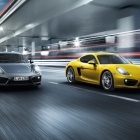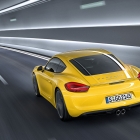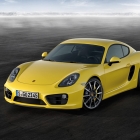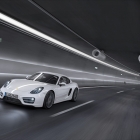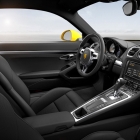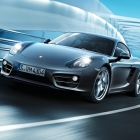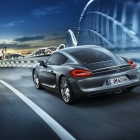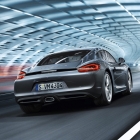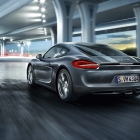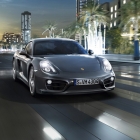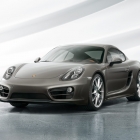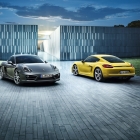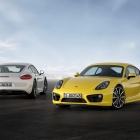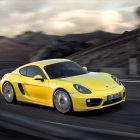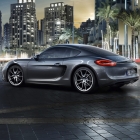
Making you forget about that 911 since 2005.
When the Porsche Cayman made its debut in 2005 it was looked at as a “Boxster with a fixed roof”. And while you could look at that as either a good or a bad thing, its driving dynamics have never been called into question. In fact, some actually believed that if Porsche put more effort into the mid-engined sports car, they would’ve outdone their own 911.
The third-generation Porsche Cayman model line is different. It looks, feels, and drives differently than its drop-top sibling and separates itself from the 911 – in a good way. While the German automaker continues to use a similar design on each model the new Porsche Cayman and Cayman S are a bit more distinct and recall styling cues from historic models like the 904, 908, and others. The sports car is also more efficient, powerful, and capable than ever before, and loaded with excitement.
The new Cayman and Cayman S models now have a longer wheelbase, wider track, and larger wheels that make it a true Porsche sports car while also providing a dynamic driving experience. Smooth lines and curves are paired up with sharp, sculpted edges that flow from the front of the car and create an impression of speed and movement. The longer, lower shape is emphasized by the windshield that is extended forward and a roofline that flows past the rear axle. Air inlets are featured at both of the rear fenders are sculpted into the doors and lower side panels to redirect air and cool the engine. The front fascia is more distinct with new air intakes that grow outward towards the sides of the sports car. A new design is featured at the rear that creates an athletic appearance along with a spoiler that is larger and automatically extends at a steeper angle than the unit utilized by the Porsche Boxster (981).
One of the most important parts of the new Porsche Cayman and Cayman S models is what’s underneath the sheet metal. The sports car is now up to 66 lbs. lighter than the previous model (depending on variant and equipment), which works with the retuned suspension, and new equipment to improve upon the already superb handling dynamics. New Porsche Torque Vectoring (PTV) utilizes the rear differential to vary the torque distribution of the inner- and outer wheel for better handling, and is available as an option. Porsche Stability Management (PSM) comes standard to offer somewhat of a safety net for drivers while 315- and 330 mm front brake discs with four-piston monobloc calipers provide safe and reliable stopping power. As an option, customers can equip their Cayman models with Porsche Active Suspension Management (PASM) and Porsche Ceramic Composite Brakes (PCCB) for added performance. Also, Adaptive Cruise Control (ACC), Burmester sound system, and keyless Entry and Drive systems can be ordered as options for the first time on the Cayman.

As automakers including Porsche strive towards offering more environmentally-friendly engine options, the new pair of flat-sixes in the Cayman and Cayman S has struck a superb balance of power and efficiency. The base Cayman will be powered by a 2.7-liter flat-six engine with Direct Fuel Injection (DFI) VarioCam Plus, Auto Start/Stop, Electrical System Recuperation, Integrated Dry-Sump Lubrication, and Thermal Management for efficiency and performance. Each cylinder also utilizes a resonance intake manifold and a stainless steel exhaust system where each cylinder has its own exhaust tract. The 2.7-liter produces 275 hp at 7,400 RPM and 213 lb-ft from 4,500 to 6,500 RPM, while returning lower carbon-dioxide emissions and better fuel economy (30 mpg highway with manual). The larger 3.4-liter flat-six found in the Cayman S utilizes all of the same technology as the smaller flat-six and produces 325 hp at 7,400 RPM and 273 lb.-ft. from 4,500 and 5,800 RPM, and achieves 28 mpg highway (manual).
Both of the engines in the Porsche Cayman and Cayman S models will come standard with a six-speed manual and the seven-speed, superfast, PDK transmission as an option. When equipped with the Sport Chrono Package, each transmission is given dynamic transmission mounts that can reduce drivetrain vibration or provide better handling dynamics.

Performance for the Porsche Cayman model is respectable with 0 to 60 mph taking just 5.4 seconds and a 165 mph top speed with the manual, while PDK-equipped models can do the same sprint in 5.3 seconds and reach 164 mph. After checking the Sport Chrono box, acceleration is reduced all the way down to 5.1 seconds. As for the more powerful Cayman S, the manual-equipped models go from 0-60 mph in 4.7 seconds and to a top speed of 174 mph while the PDK models offer a 4.6-second 0-60 mph time and 174 mph top speed. With the Sport Chrono package, acceleration is reduced to a mere 4.4 seconds.
The new Porsche Cayman and Cayman S models should be available at dealerships worldwide in March of 2013. Pricing for the base Cayman will start at $52,600 in the United States while the Cayman S will start at $63,800.
Porsche Cayman and Cayman S Video
httpv://youtu.be/vQJdNmvuI0E
httpv://youtu.be/_kqOxyLc4Kc
Porsche Cayman and Cayman S Specifications
[toggle title=”Cayman”]
Engine:
Displacement: 3.4 liters
Number of Cylinders: Flat-six
Aspiration: Naturally aspirated
Maximum Horsepower: 275 hp at 7,400 RPM
Maximum Torque: 213 lb-ft. from 4,500 to 6,500 RPM
Transmission:
Type: Six-speed manual
Optional: Seven-speed PDK
Performance:
Acceleration 0-60 mph: 5.4 s (manual)/5.3 s (PDK)/ 5.1 s (PDK w/Sport Chrono)
Top Speed: 164 mph (manual and PDK)
[/toggle]
[toggle title=”Cayman S”]
Engine:
Displacement: 3.4 liters
Number of Cylinders: Flat-six
Aspiration: Naturally aspirated
Maximum Horsepower: 325 hp at 7,400 RPM
Maximum Torque: 273 lb.-ft. from 4,500 and 5,800 RPM
Transmission:
Type: Six-speed manual
Optional: Seven-speed PDK
Performance:
Acceleration 0-60 mph: 4.7 s (manual)/4.6 s (PDK)/ 4.4 s (PDK w/Sport Chrono)
Top Speed: 175 mph (manual)/174 mph (PDK)
[/toggle]
Porsche Cayman and Cayman S Gallery
[Source: Porsche]
Would you rather take the Porsche Cayman model over the Boxster or the 911? Leave a comment and let us know!

